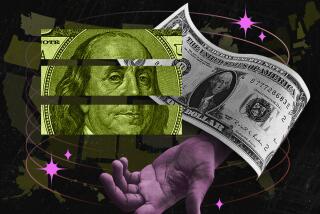No, the average U.S. household hasn’t recovered its wealth

- Share via
The hands-down winner for most misleading trope of the day goes to the notion that U.S. households have now recovered all the wealth they lost during the recession and that their net worth is now at a record high. The raw statistics, from the Federal Reserve, inspired a surge of optimistic reporting on what this means for the economic recovery going forward.
You have to read pretty far down in most of the reports to discern that the average U.S. household has been on the outside looking in during this so-called recovery. And to get the full, fair story, you have to triangulate the Fed statistics with several that aren’t in the latest report.
The Fed does observe that stock prices and home values are the most important drivers of the aggregate recovery. That’s a red flag right there. Equity ownership is very unevenly distributed in the U.S.; only about half of all households are exposed to equity prices at all, mostly through mutual funds and pension funds. But the bottom 80%, by income, hold only about 20% of all equity wealth. The top 1% holds about 40% of all stock market wealth.
Don’t be misled by the pension fund aspect. For most households this is watered-down exposure: Pension assets are a small fraction of household wealth, and the share attributable to equity holdings is smaller still. The equity recovery may have especially left seniors behind. People in retirement or near-retirement lost a huge share of their equity nest eggs at the wrong moment; they may have been too gun-shy to keep the remainder of their portfolios still in stocks so they missed out on the surge.
Equity prices may be hitting new highs this year, but home values, which encompass most of the net worth of middle- and working-class households, are still in the muck. Since bottoming out last year (based on the S&P/Case-Shiller home price index), home prices have recovered all the way back to their level in the first quarter of 2004. It’ll be a while before the average homeowning household feels recovered.
Even talking about net worth as a metric of recovery is a bit misleading. The real issue is income. If anything, the crash strengthened the trend of increasingly unequal distribution of income. The leading chronicler of this trend is Emmanuel Saez of UC Berkeley. His latest analysis, issued in September, found that the top 1% captured fully 95% of all income growth since the recovery began in 2009. That’s the largest share, by far, of any recovery since 1993. Income growth for the bottom 99% during this recovery, Saez calculates, came to a handsome 0.4%.
Government earnings statistics tell more of the story. The Bureau of Labor Statistics reports that median weekly earnings have actually fallen between 2009 and the third quarter of this year when adjusted for inflation. The median worker, in other words, is falling behind. The gains are all an illusion.
So it may be that the U.S. household, taken in the aggregate and averaged out, has recovered its wealth since the recession. What’s certain is that most U.S. households have gotten measurably poorer.
More to Read
Inside the business of entertainment
The Wide Shot brings you news, analysis and insights on everything from streaming wars to production — and what it all means for the future.
You may occasionally receive promotional content from the Los Angeles Times.











